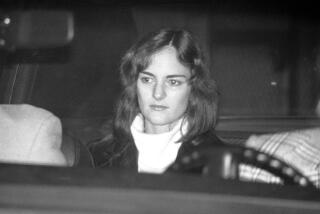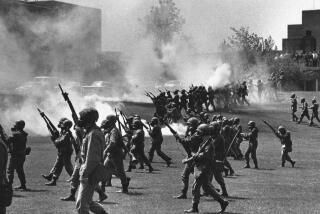Review: ‘The Witness’ powerfully revisits the murder of Kitty Genovese
At first glance, the title of “The Witness” would seem to reference the 38 residents of Kew Gardens in Queens, N.Y., who were pilloried in the press for their apparent indifference to the screams of 28-year-old Kitty Genovese as she was stabbed to death outside their windows. In the decades since that night in March 1964, Genovese has been held up as a tragic victim of bystander apathy in the big city, though one of the key accomplishments of this quietly revelatory documentary is that it sees the people in this tragedy as more than just convenient scapegoats or symbols. Not all those 38 neighbors were as cruelly indifferent as the public was led to believe, and Kitty herself, as one person passionately attests here, “was so much more than her last 30 minutes.”
That person is Kitty’s younger brother, Bill, the film’s chief camera subject, its driving force and the real witness of the title. No passive observer, he is instead an active investigator and interpreter of events that forever changed his family’s life. Only 16 at the time of his sister’s death, Bill joined the Marines a few years later and went to Vietnam, where he lost both his legs — a setback that, whatever it may have cost him in mobility, seems to have sapped none of his determination. Now in his 60s, hoisting himself up stairs and climbing in and out of a wheelchair, he could scarcely seem more energetic — or more inspiring — in his dogged pursuit of the truth.
The strength of “The Witness” lies in its recognition that the truth is often not just elusive but unattainable. To call the film a debunking or a corrective would ascribe to it a level of knowledge that neither Bill Genovese nor director James Solomon, a screenwriter making a fine nonfiction filmmaking debut, claims to possess. Instead they throw themselves into the hunt with unflagging resolve, turning a sober reflection on tragedy into a lively and unpredictable detective story, and evincing at every step a sense of initiative that is the very opposite of apathy.
Along the way, they revisit the grim timeline of the murder, using animation and crime-scene photographs to piece together the half hour during which Kitty was attacked on two separate occasions by her killer, Winston Moseley. (He was scared off at first by a neighbor’s warning, but later returned when it became clear that no one was coming to the woman’s aid.)
The film also pokes holes in the New York Times’ original report on those 38 Bad Samaritans — a story spearheaded by editor A.M. Rosenthal, and one that the newspaper first called into question in 2004, on the 40th anniversary of Kitty’s death. Rosenthal (who later wrote the book “Thirty-Eight Witnesses: The Kitty Genovese Case”) is seen defending the report, though other journalists, including Mike Wallace, admit they accepted the Times’ version of events mainly due to the paper’s clout.
Bill seeks out as many surviving members of the 38 (almost certainly an inaccurate figure) as he can, though it soon becomes clear that some of the witnesses may not have even realized they were witnesses, or indeed fully understood what was happening in the streets below. One neighbor remembers calling the police, only to be told by a clerk that they had already been notified. And in at least one case there is a powerful moment of consolation, as it’s revealed that Kitty, despite the unfathomable horror of her ordeal, did not face it entirely alone.
Inevitably, Bill’s search forces him to reckon with Moseley and his history of violent misdeeds, before and even after his arrest and conviction. Remarkably thoughtful and balanced in his consideration of his sister’s killer, he entertains the notion of forgiveness and wonders whether he should seek a meeting with him in prison. (Moseley died there in April, several months after the film’s completion.) This line of inquiry leads to one of the film’s most poignant and surprising encounters — a scene that optimistically suggests that mercy, rather than danger, might be lying in wait for all of us.
In the end, “The Witness” returns to Kitty Genovese, hewing to the principled notion that her life is worthier of lasting commemoration than her death. As Bill sifts through old photographs and snippets from home movies, and has lively arguments with his other siblings (who are far more ready to move on than he is), his search is shown to be an inescapably personal one: He admits having never really known the sister who was 12 years his senior, and who would visit the family home in Connecticut on weekends away from her busy, exciting life in New York. The often brushed-aside matter of Kitty’s homosexuality is examined in an interview with Mary Ann Zielonko, her romantic partner at the time; among other things, Solomon’s film provides a fascinating snapshot of gay life in New York a few years before the Stonewall riots.
The looming specters of violence and gay oppression are among the reasons why “The Witness,” through no calculation of its own, feels like essential viewing at this particular moment. The narrative of social apathy — so heroically countered recently by the two students who came to a woman’s aid in the Brock Turner rape case — is still another. Toward the end of the film there is an astonishing sequence, almost unbearable in its audacity, that suggests such acts of goodness remain few and far between.
It’s an observation offered up without blame or judgment. The point that “The Witness” leaves us with is not that humanity is cruel or cowardly by nature. It’s that the question of who we really are, and how we might react, is a mystery that neither the most sensational headline nor the most thoughtful film can solve.
------------
‘The Witness’
Unrated
Running time: 1 hour, 29 minutes
Playing: In limited release
justin.chang@latimes.com
More to Read
Only good movies
Get the Indie Focus newsletter, Mark Olsen's weekly guide to the world of cinema.
You may occasionally receive promotional content from the Los Angeles Times.











